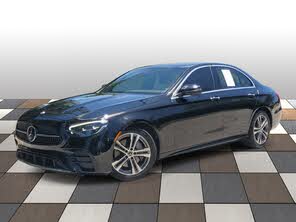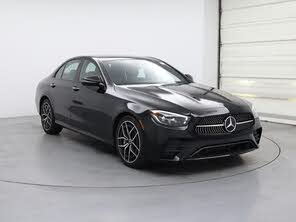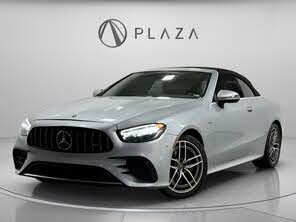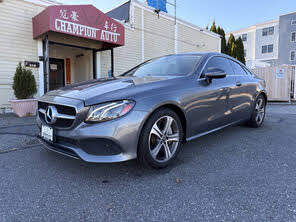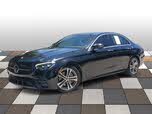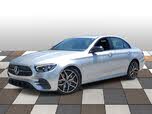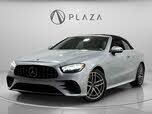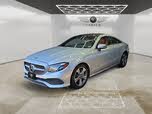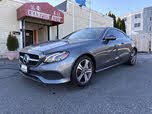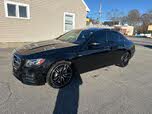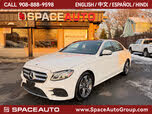2021 Mercedes-Benz E-Class vs 2020 Mercedes-Benz E-Class
Overview | |
MSRP$54,050 | MSRP$54,250 |
Listings256 | Listings290 |
Ratings & Reviews | |
User Reviews | User Reviews |
Expert reviews8.0 out of 10 | Expert reviews8.3 out of 10 |
Pros
Cons
| Pros
Cons
|
2020 Mercedes-Benz E-Class Reviews SummaryA Mercedes-Benz is a physical indulgence that gives as much or as little pleasure as your checking account allows. The 2020 E-Class starts off well-equipped in ways a $55,000 Mercedes wasn't just a few years ago, and it becomes decadent and power-drunk once you start adding options. For 2020, a new base engine joins this car's stellar design, technology, and effortless demeanor. | |
2021 Mercedes-Benz E-Class Reviews SummaryWhen money is but a mild concern, a brand-new Mercedes-Benz is a reasonable purchase. The E-Class is the company's most practical and versatile car, as high-quality and necessary in a nice garage as a Kitchen-Aid mixer is in a baker's kitchen. It offers four body styles, four engines, and dozens of color schemes. Fast or efficient? Loud or library quiet? Modest or rich as hell? The E-Class is all of those things, depending on which of the 13 models you order and how deep into the options list you dive. For 2021, the E-Class receives a mid-cycle update for the infotainment system, engines, and exterior styling. We tested the AMG E53 that features a mild-hybrid inline-six powertrain. | |
Popular Features & Specs | |
Engine2.0L 255 hp I4 | Engine2.0L 255 hp I4 |
Drive TrainRWD | Drive TrainRWD |
Seating Capacity5 | Seating Capacity5 |
Horsepower255 hp @ 5800 rpm | Horsepower255 hp @ 5800 rpm |
MPG City23 | MPG City22 |
MPG Highway32 | MPG Highway31 |
Engine | |
Engine Name2.0L 255 hp I4 | Engine Name2.0L 255 hp I4 |
Torque273 lb-ft @ 1800 rpm | Torque273 lb-ft @ 1800 rpm |
Horsepower255 hp @ 5800 rpm | Horsepower255 hp @ 5800 rpm |
DrivetrainRWD | DrivetrainRWD |
Fuel Economy | |
MPG City23 | MPG City22 |
MPG Highway32 | MPG Highway31 |
Interior | |
Seating Capacity5 | Seating Capacity5 |
Key Features | |
Navigation SystemStandard | Navigation SystemStandard |
Sunroof/MoonroofStandard | Sunroof/MoonroofStandard |
Safety | |
Front Crash Overall5 | Front Crash Overall5 |
Side Crash Overall5 | Side Crash Overall5 |
Dimensions & Capacity | |
Cargo Space13.1 cu ft | Cargo Space13.1 cu ft |
Curb Weight3814 lbs | Curb Weight3781 lbs |
Height57.8 in | Height57.8 in |
Length193.8 in | Length194.3 in |
Width81.3 in | Width81.3 in |
Wheelbase115.7 in | Wheelbase115.7 in |
Number of doors4 | Number of doors4 |
Overview | ||
MSRP | $54,050 | $54,250 |
Listings | ||
Ratings & Reviews | ||
User reviews | ||
Expert reviews | 8.0 out of 10Read full review | 8.3 out of 10Read full review |
Pros & cons | Pros
Cons
| Pros
Cons
|
Summary | A Mercedes-Benz is a physical indulgence that gives as much or as little pleasure as your checking account allows. The 2020 E-Class starts off well-equipped in ways a $55,000 Mercedes wasn't just a few years ago, and it becomes decadent and power-drunk once you start adding options. For 2020, a new base engine joins this car's stellar design, technology, and effortless demeanor. | When money is but a mild concern, a brand-new Mercedes-Benz is a reasonable purchase. The E-Class is the company's most practical and versatile car, as high-quality and necessary in a nice garage as a Kitchen-Aid mixer is in a baker's kitchen. It offers four body styles, four engines, and dozens of color schemes. Fast or efficient? Loud or library quiet? Modest or rich as hell? The E-Class is all of those things, depending on which of the 13 models you order and how deep into the options list you dive. For 2021, the E-Class receives a mid-cycle update for the infotainment system, engines, and exterior styling. We tested the AMG E53 that features a mild-hybrid inline-six powertrain. |
Video | ||
Popular Features & Specs | ||
Engine | 2.0L 255 hp I4 | 2.0L 255 hp I4 |
Drive Train | RWD | RWD |
Seating Capacity | 5 | 5 |
Horsepower | 255 hp @ 5800 rpm | 255 hp @ 5800 rpm |
MPG City | 23 | 22 |
MPG Highway | 32 | 31 |
Engine | ||
Engine Name | 2.0L 255 hp I4 | 2.0L 255 hp I4 |
Torque | 273 lb-ft @ 1800 rpm | 273 lb-ft @ 1800 rpm |
Horsepower | 255 hp @ 5800 rpm | 255 hp @ 5800 rpm |
Drivetrain | RWD | RWD |
Fuel Economy | ||
MPG City | 23 | 22 |
MPG Highway | 32 | 31 |
Interior | ||
Seating Capacity | 5 | 5 |
Key Features | ||
Navigation System | Standard | Standard |
Sunroof/Moonroof | Standard | Standard |
Safety | ||
Front Crash Overall | 5 | 5 |
Side Crash Overall | 5 | 5 |
Dimensions & Capacity | ||
Cargo Space | 13.1 cu ft | 13.1 cu ft |
Curb Weight | 3814 lbs | 3781 lbs |
Height | 57.8 in | 57.8 in |
Length | 193.8 in | 194.3 in |
Width | 81.3 in | 81.3 in |
Wheelbase | 115.7 in | 115.7 in |
Number of doors | 4 | 4 |
The 2020 Mercedes-Benz E-Class drew significant inspiration from its 2017 redesign, reigniting elements from the E-Class of two generations prior. The car exhibited a rounded, smooth body emphasized by a streamlined design that some critics believed could benefit from more pronounced edges. Mercedes-Benz addressed this in the 2021 facelift. The 2020 E-Class retained visual continuity within the Mercedes family, mirroring the larger S-Class and smaller C-Class. Available in sedan, wagon, coupe, or convertible, the E-Class catered to conservative tastes, with standout features like the traditional hood ornament and thin-laced chrome grille.
Luxurious materials and a smooth, creaseless design defined the 2020 model, especially evident in the cabriolet trim with its contrast-enhancing soft top. An opulent interior featured multi-tone leathers, aluminum, deep-polished wood, and two extensive high-res digital screens spanning the dashboard. Circular air vents, knurled silver toggles, and ambient lighting in 64 colors added to the refined ambiance. Despite lacking cutting-edge infotainment, the 2020 E-Class provided a solitary retreat through heated armrests, massaging seats, and plush textures, even in the entry-level models.
In contrast, the 2021 Mercedes-Benz E-Class evolved with subtle yet impactful updates enhancing its sophistication. The W213-generation's curvy form received a tweak, introducing edgier front elements like squinted headlights and an inverted trapezoid grille, while the rear adopted horizontal taillights reminiscent of earlier designs. This facelift introduced new bumpers with larger air intakes, exhaust tips, and wheels, all contributing to a fresh yet elegant aesthetic.
Classic elements like the standing hood ornament on sedans and wagons were omitted. Although the Sport package with a giant Mercedes emblem in the grille gained popularity, some considered it gaudy, particularly the backlit version. Regardless, the AMG models with vertical grille slats carried off the bold look suitably. Despite these changes, the Mercedes E-Class maintained its reputation as a reserved, elegant vehicle with vast material excellence inside. Rich woods, aluminum, and carbon fiber, along with intricate detailing, created an unmatched cabin environment. The updated steering wheels and standard digital display pushed the 2021 model's interior beyond expectations.


















The 2020 Mercedes-Benz E-Class introduced the E350 model, featuring a turbocharged 2.0-liter 4-cylinder engine with 255 horsepower and 273 pound-feet of torque. This engine, paired with a 9-speed automatic transmission, delivered improved response and prolonged gear holding. Although quieter and fairly responsive in Comfort mode, the momentum faded above 40 mph, making some passing maneuvers challenging. The E350's high weight and mediocre 4-cylinder performance warranted consideration for the more robust E450 model.
The E450 boasted a 3.0-liter V6 engine generating 362 horsepower and 369 pound-feet of torque through a twin-turbo setup, offering effortless performance befitting the luxurious E-Class. AMG models like the E53 incorporated an electric motor-generator, achieving 429 horsepower and 384 pound-feet of torque and showcasing performance-oriented features like adaptive dampers and barking exhausts. The AMG E63 S was the pinnacle, delivering 603 horsepower and 627 pound-feet of torque from a 4.0-liter twin-turbo V8, equipped with AWD and a drift mode.
For 2021, Mercedes substituted conventional V6 engines with electrified inline-six powertrains in high-volume models like the E450. This hybrid system integrated a 48-volt electric starter-generator with a 3.0-liter engine generating 362 horsepower and 369 pound-feet of torque, offering smooth performance and improved emissions compliance.
The base E350’s upgraded 2.0-liter 4-cylinder engine remained, but it continued to underwhelm in terms of performance. Conversely, the AMG E53’s addition of a second turbo charger powered by the 48-volt battery enhanced acceleration without compromising the driving experience, delivering 429 horsepower and 384 pound-feet of torque. The AMG E63 S stood apart, incorporating a beltless 4.0-liter V8 paired with a 48-volt system, achieving high performance with 603 horsepower and 627 pound-feet of torque.
The 2020 Mercedes-Benz E-Class, though lagging behind newer models in infotainment, featured a 12.3-inch screen system managed by a non-touch interface, COMAND, which felt outdated and overly complex. Operating it required navigating several menus, a distraction while driving. However, practical features like seat controls on the doors, ample passenger and cargo space, and useful sightlines made the E-Class feel functionally sound. Standout aspects included a spacious coupe rear seat and the sedan's rear-facing jump seat, a nostalgic yet handy feature for families. Practical elements like a footwell net for smaller items highlighted its user-friendly design.
The 2021 Mercedes-Benz E-Class refined these aspects with an updated MBUX system, now touch-enabled, simplifying everyday tasks. Although the redesigned steering wheel touchpads were less intuitive, the user experience improved overall. Essential controls like climate settings and seat adjustments on the doors remained, underscoring Mercedes' commitment to usability. Despite some features like rear USB ports and heated rear seats missing in higher trims, the interior continued to provide ample space and support.
Cargo capacities varied: the sedan offered 13 cubic feet, while the coupe provided around 10 cubic feet, with less space in the convertible variant when the top was down. The 2021 model introduced the E450 All-Terrain wagon with 35 cubic feet of cargo space, expandably up to 64 cubic feet, optimized for more rugged usage.
In 2020, the Mercedes-Benz E-Class featured an impressive array of advanced technologies, despite an initially daunting interface. Semi-automated driving aids, including lane-changing assistance and adaptive cruise control, were part of a comprehensive Driver Assistance Package. The car's V2X system communicated with other Mercedes vehicles about road conditions, while the configurable digital dash and surround-sound Burmester stereo added depths of personalization and entertainment.
By 2021, the improved MBUX system, known for its touch interface and voice control, marked a significant leap forward. Features like natural voice commands, live camera feeds with directional overlays, and gesture controls enhanced user experience. Although the odoriferous Energizing Comfort Package persisted, more practical features like massaging seats with kinetic adjustments and a more streamlined interface defined the new tech setup.
Options included enhanced driver assistance systems capable of semi-autonomous actions, though the system didn't update over-the-air and wireless smartphone integration remained absent. However, conveniences like a wireless charging pad and 4G WiFi standardization demonstrated Mercedes' tech-forward approach. The ability to customize the digital display offered a uniquely futuristic appeal unmatched by rivals.
The 2020 E-Class sedan and wagon earned a 5-star overall rating from NHTSA, achieving the highest scores in all crash tests, affirming its status as one of the safest vehicles. IIHS also awarded it the Top Safety Pick+ designation. Innovative features like Pre-Safe Sound and seat bolsters that inflated during side collisions underscored its advanced safety engineering. Standard safety features included forward emergency braking and driver-attention monitoring, with an extensive array of optional driver-assist features enhancing overall safety.
By 2021, the E-Class sedan and wagon continued to achieve top safety ratings, though the driver’s side received a four-star rating in the frontal crash test. The coupe and cabriolet retained similar safety innovations, maintaining stability and protection. Standard safety features remained robust, with forward automatic emergency braking, driver-attention monitors, and blind-spot monitoring. Some optional features, unique to Mercedes, set a benchmark for industry safety advancements.
CarGurus highlights

According to CarGurus experts, the overall rating for the 2020 Mercedes-Benz E-Class is 8.0 out of 10, while the 2021 Mercedes-Benz E-Class scores 8.3 out of 10. Given these ratings, the 2021 Mercedes-Benz E-Class edges out its predecessor, offering superior technological integration, updated design, and advanced hybrid powertrains. For those seeking the latest in automotive innovation, enhanced aesthetics, and better eco-friendly performance, the 2021 model stands as the preferred choice.
Choose the 2021 Mercedes-Benz E-Class if:
- You value the latest technology advancements like the MBUX system and touchscreens.
- You want a mild hybrid powertrain with improved fuel efficiency and reduced emissions.
- You are looking for a refreshed design with more aggressive styling elements and newer safety upgrades.
Choose the 2020 Mercedes-Benz E-Class if:
- You prefer a classic Mercedes design with features like the traditional hood ornament.
- You seek a luxurious interior with premium materials and extensive customization options.
- You prioritize a cushy and comfortable ride quality with a supple suspension system.
CarGurus highlights

According to CarGurus experts, the overall rating for the 2020 Mercedes-Benz E-Class is 8.0 out of 10, while the 2021 Mercedes-Benz E-Class scores 8.3 out of 10. Given these ratings, the 2021 Mercedes-Benz E-Class edges out its predecessor, offering superior technological integration, updated design, and advanced hybrid powertrains. For those seeking the latest in automotive innovation, enhanced aesthetics, and better eco-friendly performance, the 2021 model stands as the preferred choice.
Choose the 2021 Mercedes-Benz E-Class if:
Shop Now- You value the latest technology advancements like the MBUX system and touchscreens.
- You want a mild hybrid powertrain with improved fuel efficiency and reduced emissions.
- You are looking for a refreshed design with more aggressive styling elements and newer safety upgrades.
Choose the 2020 Mercedes-Benz E-Class if:
Shop Now- You prefer a classic Mercedes design with features like the traditional hood ornament.
- You seek a luxurious interior with premium materials and extensive customization options.
- You prioritize a cushy and comfortable ride quality with a supple suspension system.

By: CarGurus + AI
At CarGurus, our team of experienced automotive writers remain at the heart of our content operation, conducting hands-on car tests and writing insightful guides that are backed by years of industry experience. To complement this, we are harnessing AI to make our content offering more diverse and more helpful to shoppers than ever. To achieve this, our AI systems are based exclusively on CarGurus content, ratings and data, so that what we produce is both unique to CarGurus, and uniquely helpful to car shoppers.



